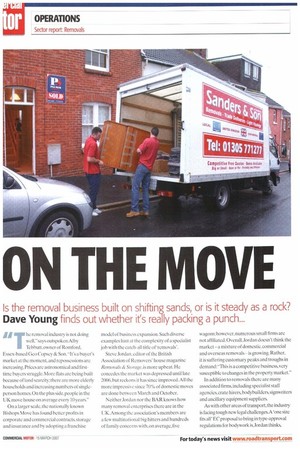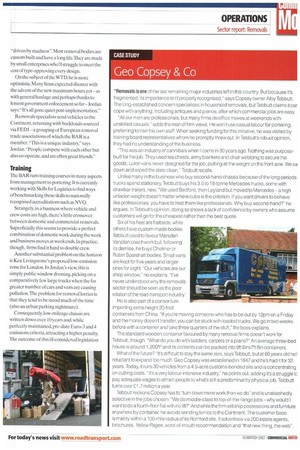ON THE MOVE
Page 48

Page 49

Page 50

If you've noticed an error in this article please click here to report it so we can fix it.
Is the removal business built on shifting sands, or is it steady as a rock? Dave Young finds out whether it's really packing a punch...
„T he removal industry is not doing well," says outspoken Alby
Tebbutt, owner of Romford, Essex-based Geo Copsey & Son."It's a buyer's market at the moment, and repossessions are increasing. Prices are astronomical and firsttime buyers struggle. More flats are being built because of land scarcity there are more elderly households and increasing numbers of singleperson homes. On the plus side, people in the UK move house on average every 10 years."
On a larger scale, the nationally known Bishops Move has found better profits in corporate and commercial contracts, storage and insurance and by adopting afranchise model of business expansion. Such diverse examples hint at the complexity of a specialist job with the catch-all title of 'removals'.
Steve Jordan, editor of the British Association of Removers' house magazine Removals ci Storage. is more upbeat. He concedes the market was depressed until late 2006, hut reckons it has since improved. All the more impressive since 70% of domestic moves are done between March and October.
Neither Jordan nor the BAR knows how many removal enterprises there are in the UK. Among the association's members are a few multinational big hitters and hundreds of family concerns with, on average, five wagons; however, numerous small firms are not affiliated. Overall, Jordan doesn't think the market —a mixture of domestic, commercial and overseas removals—is growing. Rather, it is suffering customary peaks and troughs in demand: 'This is a competitive business, very susceptible to changes in the property market."
In addition to removals there are many associated firms, including specialist staff agencies, crate hirers, bodybuilders, signwriters and ancillary equipment suppliers.
As with other areas of transport, the industry is facing tough new legal challenges.A 'one size fits all' EC proposal to bring in type-approval regulations for bodywork is, Jordan thinks, "driven by madness". Most removal bodies are custom built and have along life.They are made by small enterprises who'll struggle to meet the cost of type-approving every design.
On the subject of the WTD, he is more optimistic. Many firms expected disaster with the advent of the new maximum hours, yet-as with general haulage and perhaps thanks to lenient government enforcement so far-Jordan says: "It's all gone quiet post-implementation."
Removals specialists send vehicles to the Continent, returning with backloads sourced via FEDI a grouping of European removal trade associations of which the BAR is a member. "This is a unique industry," says Jordan."People compete with each other but also co-operate, and are often great friends."
Training
The BAR runs training courses in many aspects from management to portering. It is currently working with Skills for Logistics to find ways of benchmarking these skills to nationally recognised accreditations such as NVQ.
Strangely, in a business where vehicle and crew costs are high, there's little crossover between domestic and commercial removals. Superficially this seems to provide a perfect combination of domestic work during the week and business moves at weekends. In practice, though, firms find it hard to double crew.
Another substantial problem on the horizon is Ken Livingstone's proposed low-emission zone for London. In Jordan's view, this is simply public window dressing, picking on a comparatively few large trucks when the far greater number of cars and vans are causing pollution.The problem for removal lorries is that they tend to be stood much of the time (also an urban parking nightmare).
Consequently, low-mileage chassis are written down over 10 years and, while perfectly maintained, pre-date Euro-3 and 4 emissions criteria, attracting a higher penalty. The outcome of this ill-considered legislation ill,Jordan believes, make no difference to air uality, but put small employers out of business. Sales director Cohn Kellaway of Havantased Robin Sparshatts has a useful overview n industry trends as a removal-vehicle body applier. Where once Lutons were used to gain very inch of capacity, now the area above the this usually accommodation for driver and rew. It is increasingly hard to recruit staff, decent facilities such as microwaves and lowers are by no means unknown.
Instead of traditional wood, Sparshatts astom-bui ids around 100 removal bodies a ear in aluminium. glass-reinforced plasticiced ply and Multi-glass, a dense, smooth iRP formulation resistant to impact damage fith no intermediate panel joins, giving an leal base for painting and signwriting. Vans re available in aluminum frameworks, with alvanised steel underframes,opaque one-piece .7)ofs and heavy-duty container deck flooring. The cabs remain tilting and, to take the xtra weight, they use special fire enginepecification hydraulic rams. Sparshatts works losely with chassis manufacturers, often isiting customers with inexperienced dealer ales staff to help get the details correct. A fully edged removal-van body on a new chassis /ill cost anything from .E70.000 to .£80,000 epending on fittings. Bodies start at around 25,000 and properly looked after have a long fe, often being transplanted to a new chassis. Kellaway has noticed a recent customer reference for Scanias. Air suspension is lecoming very popular, as are requests to set prime movers up to pull drawbar trailers. There's a move towards nine-tonne front axles to prevent overloading, especially with crewpods. New technology also figures,with customers wanting sat-nay, insurance alarms and immobilisers. Sparshatts' 22 skilled shopfloor staff build mainly in the 7.5 to 18-tonne weight range for customers such as John Lewis.
Conclusion
Should you consider entering this sector? Competition is intense and the revenue cost of staff and trucks is very high.There's no crossover between removal vehicles and general haulage and without extensive storage facilities, you can't meet customer's needs.A man and a van stands no chance of a decent profit removers have to find added-value service add-ons. Most of the existing players appear to be at least began asfamily dynasties, in for the long term and with a wealth of hard-won skills and experience to call on. Since many people still move themselves the tipping point is thirtysornething, when most people decide to call in the professionals you might do better providing tailor-made self-drive vans and all the associated packing materials instead. But that's becoming a growth market in itself.
FACT FILE
www.removers.org.uk/joinicurrenthtml — excellent list of BAR affiliates, full contact details for specialist driving agencies, crate hire, body builders, signwriters and so on.


























































































































































































